When is the best time to hunt deer? Well, the short answer is whenever you can—right now if you possible. If the season is open and you’ve got a few hours to yourself, get out there, because there’s no telling what you might you’ll see.
The long answer is a little trickier. Life is busy and we’re all short on time and opportunity, so it makes perfect sense to want maximize your efforts by going when your are most likely to see the most deer and get a crack at tagging a buck. And while there’s no Magic 8-Ball, of course, there is a significant amount of scientific research and a whole lot in-field anecdotal evidence that can help you pick the right time of day, the right rut phase
, the ideal weather, and maybe even the perfect moon position to up your odds of success.
You shouldn’t let anything keep you from hunting if you have an inkling to go. But if you have the ability to plan ahead and you want to get the most from your time in the woods, here are the best times to hunt deer.
Table of Contents
Best Times of Day to Hunt Deer
Dusk
Dawn
Midday
The Best Times of Season to Hunt Deer
Early Season
Mid-October
Scrape Week
Seeking and Chasing Phase
Gun Season
Late Season
Best Hunting Time X-Factors
Weather
Barometer
Moon
Conclusion: Hunt When You Can
Best Times of Day to Hunt Deer—the Basics
Probably one of the first lessons in Whitetail Hunting 101 is that deer are crepuscular, a scientific term referring to critters that are most active at dawn and dusk. Even if you’re just getting into deer hunting, you’ve probably noticed in the past that the best times to spot deer are during the first hour or two after sunrise and the last hour or two before sunset. Anyone who tries to convince you otherwise is probably selling something. Loads of hardcore science has proven over and over again that deer are crepuscular, so it’s best to never forget it. Here’s how it works and how you should take advantage.
Hunt Deer at Dusk as They Move to Feed
For much of the year, deer spend quite a bit of the day bedded down and not moving much. They’ll rise once every few hours to pee, walk around a bit, and maybe nibble on some browse or acorns, and then they’ll lie down again. But once the sun starts sinking, a whitetail’s appetite kicks into gear, and deer will get up and get serious about filling their rumbling bellies. They’ll rise from their beds and putz around a little bit near their bedding spot at first. But then, relying on their memory of where the best foods are, they’ll start moving steadily toward the best groceries and settle in to feed. It’s like a person getting breakfast in the morning. You haven’t eaten for hours, and no one needs to tell you where the fridge is. Because deer are on their feet now, the hours around dusk are a great time for hunters to intercept them moving from their bedding areas to their favorite feeding areas.
Hunt Deer at Dawn as They Head to Bed
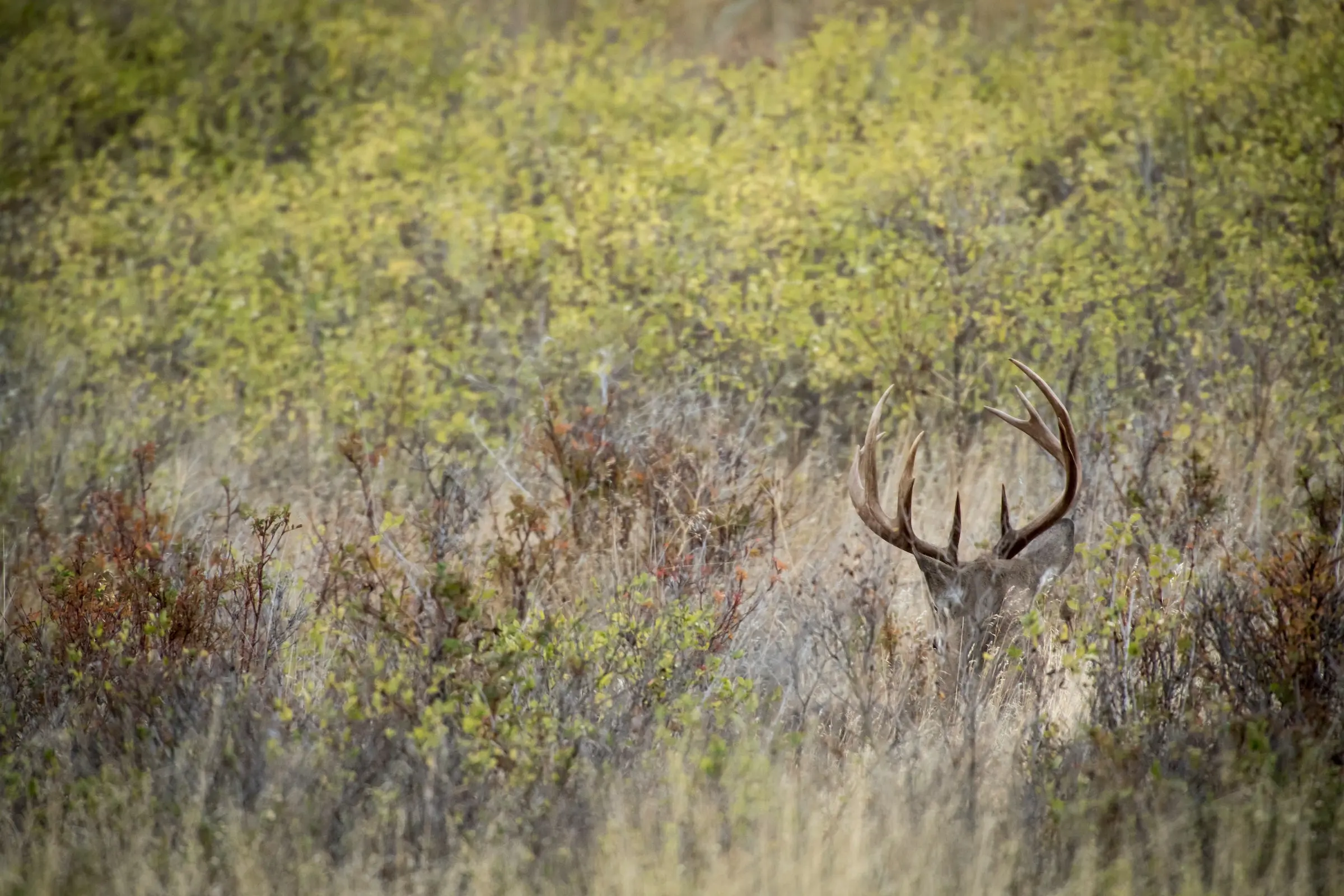
A nice whitetail buck beds in thick cover during the day. John Hafner Photography
While deer don’t typically spend the whole night eating, their stellar night vision makes them comfortable ghosting around in the darkness doing deer stuff—laying down sign, interacting with each other, and grabbing a bite whenever they feel like it. They’ll punctuate this activity with an occasional rest (my trail cameras have captured bucks laying down and bedding in one spot for up to two hours in the middle of the night), and then they’ll rise again. Because whitetails are comfortable slipping around in the dark, the first rays of dawn’s light seem to trip an internal switch that says it’s time to head for bed, and they start moving back toward the safe spots where they’ll spend the better part of the daylight period to start the cycle over again. So, morning is a good time to intercept deer moving from feeding areas back to bed.
Hunt Deer at Midday During the Rut or Severe Cold
Of course there are exceptions to every rule, and there are times when deer fall off the crepuscular wagon and move during midday. Chief among these is the rut (or breeding period), when bucks—especially mature ones—toss the dawn-and-dusk thing out the window and rise from their beds whenever they feel like it to search for a doe ready to receive their attention. The urge to breed is so strong in bucks in early to mid-November that their crepuscular nature takes a backseat to the need to cover as much ground as possible to find the next available mate. This is why savvy hunters spend as much time in the stand as possible when the calendar dates fall in the “peak breeding” window.
Another period when midday movement occurs is when severe cold settles into a region for an extended period. Feeding during the cold of night can mean expending more calories to maintain a core body temperatures than calories consumed. That’s a losing equation, so saving feeding sessions for when the sun is high and temps are warmer simply makes sense for a deer intent on survival.
And, of course, deer will move any time of day when something threatens their safety. Other hunters are the main source of this non-crepuscular movement, which means that during times when there are more hunters in the woods–such as the opening day of the gun season–you can count on deer moving throughout the day.
Best Times of the Season to Hunt Deer
As someone who’s been lucky enough to kill deer in virtually every phase of of the deer season, from the balmy bow hunts of the early season to the bitter-cold end of the late season, I firmly believe that there is no bad time to go deer hunting. That said, some parts of the season are definitely better than others. So, here are best times.
The Best Time to Hunt Deer No. 1: The Early Season
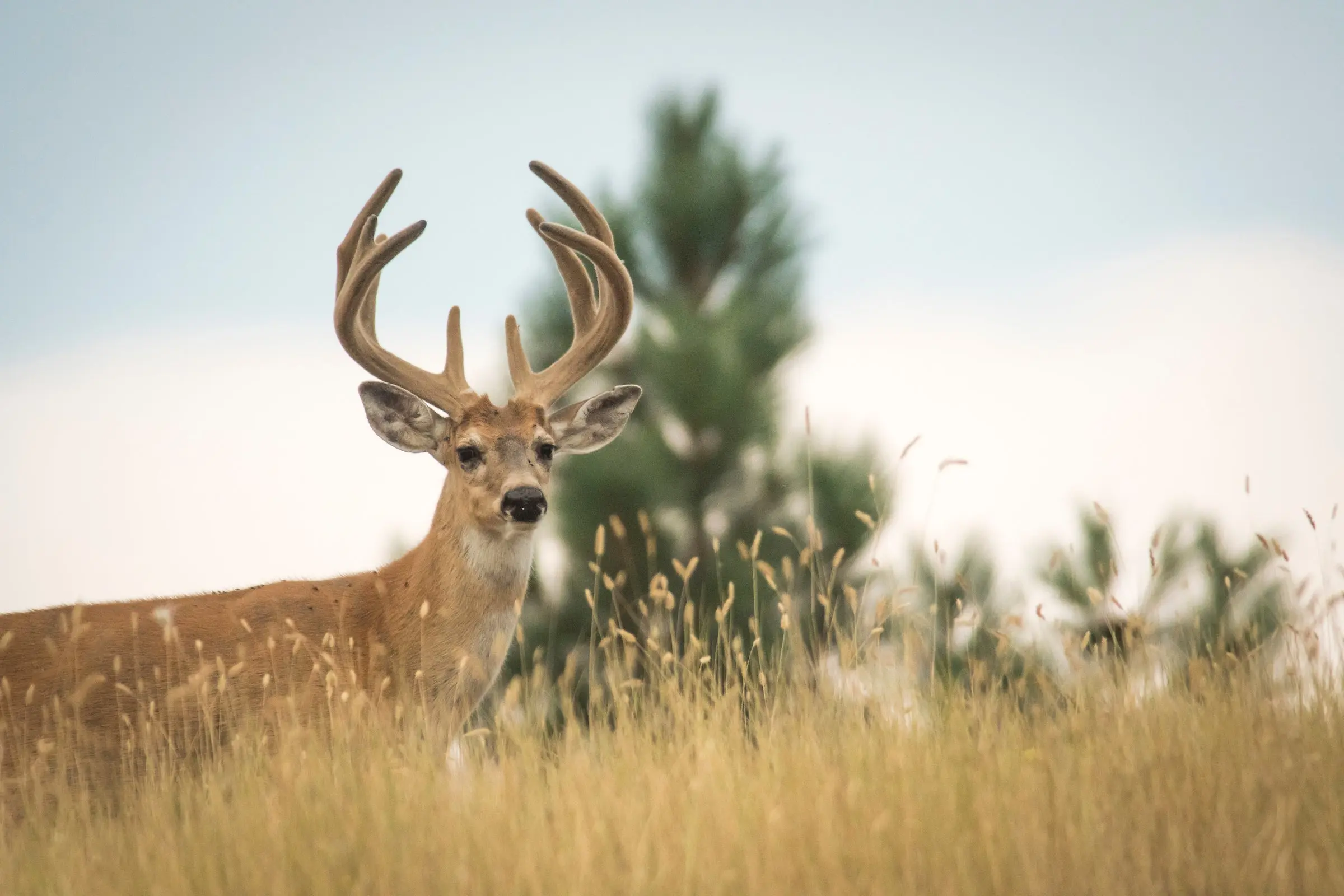
Unpressured early-season bucks will often head for food in the evenings well before dark. John Hafner Photography
November gets all the hype when it comes to tagging big whitetails, but if hunter effort in early September matched that of the 11th month, I’m comfortable in predicting that more mature bucks would hit the dirt at the first blush of season than any other time. Not only have my three biggest bucks fallen in the first two weeks of the fall hunt, but I annually cover tales of monster bucks killed during this same period.
Why is this such a great time to hunt deer? It’s mostly because bucks, even the biggest ones, are still on their late-summer/early-fall bed-to-feed pattern, which can be super predictable. Using trail cams and/or long-range observation, you can nail down the daily movements of bucks coming out to feed in the evenings and plan a simple ambush. Also, the fact that whitetails haven’t been hunted in months means they’re more relaxed about feeding in open areas like food plots, farm fields, and oak flats.
**_Related: How to Bow Hunt Deer
_**
The Best Time to Hunt Deer No. 2: The October Mini-Rut
This is such a hit-n-miss event that I hesitate to include it here but would feel like I was holding out if I didn’t. Every fall, a handful of does come into estrous about a month before the main event, and the chaos these early-cycling deer create is pretty significant. Bucks are ready and willing to breed as soon as they shed velvet, so any time a doe is equally willing, they’re going take the opportunity.
Capitalizing on this action requires you to be scouting frequently and paying close attention to buck sign. But the way I first discovered this opportunity was simply scouting a solid acorn drop for feeding sign and stumbling on some of the best rubbing and scraping activity I’d see all fall. I hung a stand immediately and put my father in it two days later; he nearly killed one of the best 8-point bucks I’d ever seen. That buck responded to rattling and grunting more aggressively than any November whitetail, and he, as well as other early-October bucks, have proven to me that there’s a serious prelude to The Big Show that every hunter should try take advantage of.
The Best Time to Hunt Deer No. 3: Scrape Week
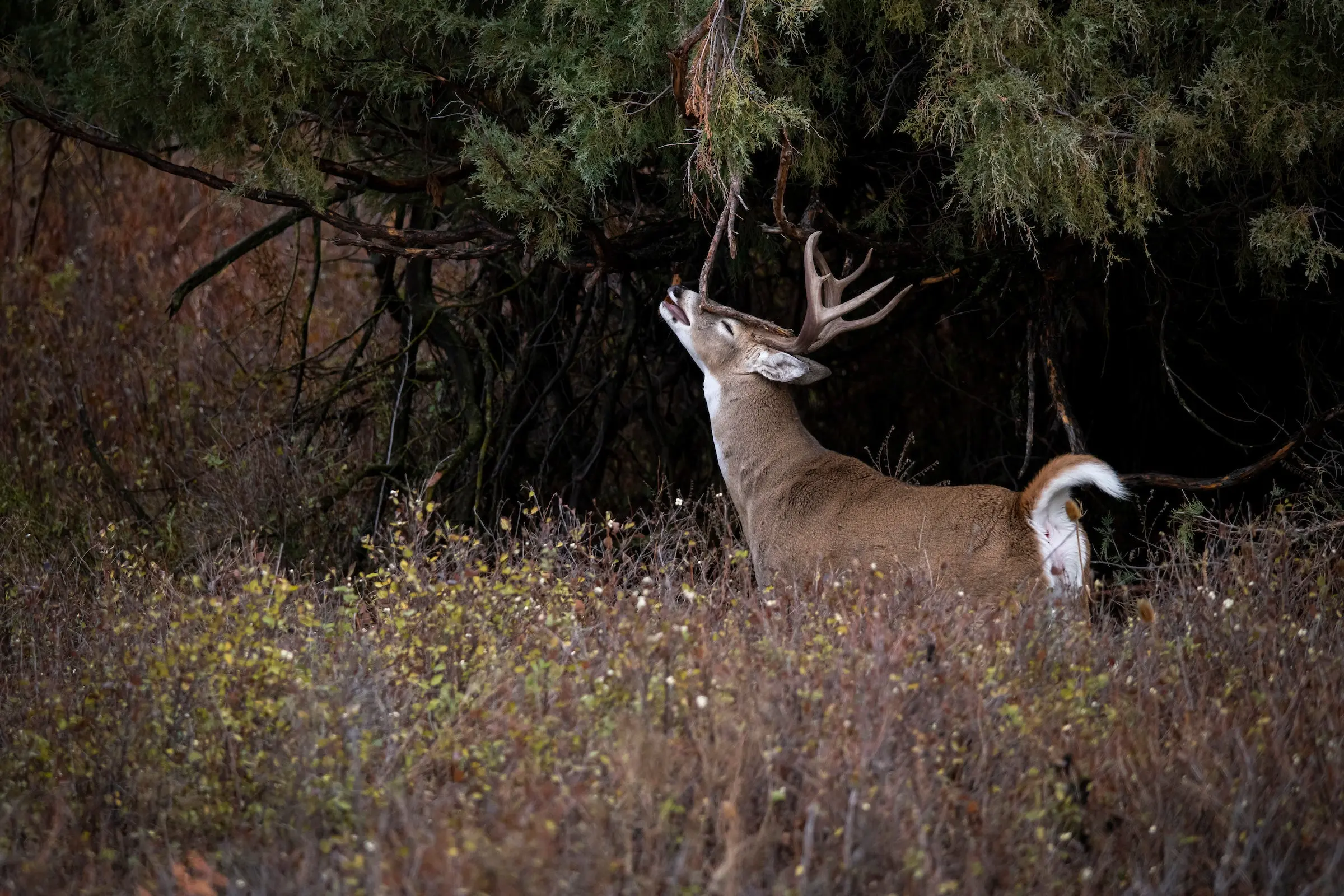
A buck work the licking branch over a scrape in broad daylight. John Hafner Photography
There are literally generations of hunters who have given up on hunting over scrapes out of frustration. The reason why is because most of time, bucks visit scrapes a night, and not during shooting hours. But there’s an exception to this rule that you should definitely make hunting time for. The key, which I learned from veteran whitetail expert Tom Indrebo of Bluff Country Outfittters
, is to focus hunting over scrapes to a narrow window of time immediately preceding the seeking-and-chase phase of the rut. During this 7-10 day phase, which happens in late October is most areas, bucks are amping up their activity, making and checking sign within their home range. The sheer volume of their visits insures that some of this activity will happen in daylight.
To take advantage, you need to keep tabs on the best and freshest scrapes on your ground, then set up on and hunt over them as much as possible. One great way to do this is to put a wireless trail camera on your best scrapes, and just keep an eye out for photos showing bucks visiting during daylight. Then jump on the action.
**_Related: The Best Days of the 2023 Whitetail Rut
_**
The Best Time to Hunt Deer No. 4: The Seeking-and-Chasing Phase
When it comes to sheer volume of deer sightings, nothing beats the seeking-and-chasing phase of the rut, when bucks start spending much more time on their feat and covering more ground to seek does, and then suddenly start chasing them all over the countryside. I’ve seen bucks caroming through the timber like heat-seeking missiles at this time of the season, chasing toward anything they think could put them in the proximity of a breeding-ready female. When most hunters think “peak rut,” this is the time period they have in mind.
This phase is the perfect time to get your hands on a grunt tube, a bleat can, and rattling antlers—and be ready to use them. I’ve been chasing deer for several decades now, and I’m continually amazed at the number of hunters who own deer calls but almost never pull them out of their pack when a nice buck is walking out of their lives. Mastering a handful of basic whitetail vocalizations is not hard, and that same deer-talk can mean the difference between a buck disappearing over the horizon and one that’s standing in easy range, searching to see the deer he just heard.
Naturally, calling is most effective and successful from stands and blinds where you’re well-camouflaged and have the wind in your favor. While some bucks will charge into a call regardless of conditions, I still like to call from what I’ve named “no-bust stands”—sites where some terrain feature or physical obstacle prevents a buck from circling downwind and catching my scent. But during the seeking-and-chasing phase, bucks can be so aggressive about interacting with other deer, that they may just come barreling straight in.
The Best Time to Hunt Deer No. 5: The Gun Season
I grew up hunting one of the most heavily-pressured management units in Wisconsin, a state where the firearms opener is a big enough event that some rural school districts close for the week. So I can tell you that the opening-day influx of human activity makes whitetails move, and savvy hunters know how to make the most of it.
The keys are to focus your efforts on the places where whitetails seek safety and the routes they take to reach those havens. One of the go-to spots in our hunting area was a 100-acre creek bottom full of spruce, tamaracks, alders, and swamp grass we called “the Big Swamp.” We generally left this escape cover alone for the first weeks of the season, and by the time we invaded it on the season’s last weekend, it was choked with deer. Other go-to spots that produced bucks during the high pressure of the firearms hunt were recent clearcuts, thick isolated covers, and travel corridors between them.
If you’re stand-hunting by yourself, as opposed to staging drives with a group, one of the keys to capitalizing on deer seeking respite from pressure is the willingness to sit as many hours as possible. There’s literally no telling when a good buck will follow a funnel to his safe spot; he’s as likely to come through at noon as he is at dawn. So the more hours you can hang in a stand or blind, the better your chance of catching a dandy skulking through the timber as he seeks a lay-up spot for the rest of the day.
The Best Time to Hunt Deer No. 6: Late Season
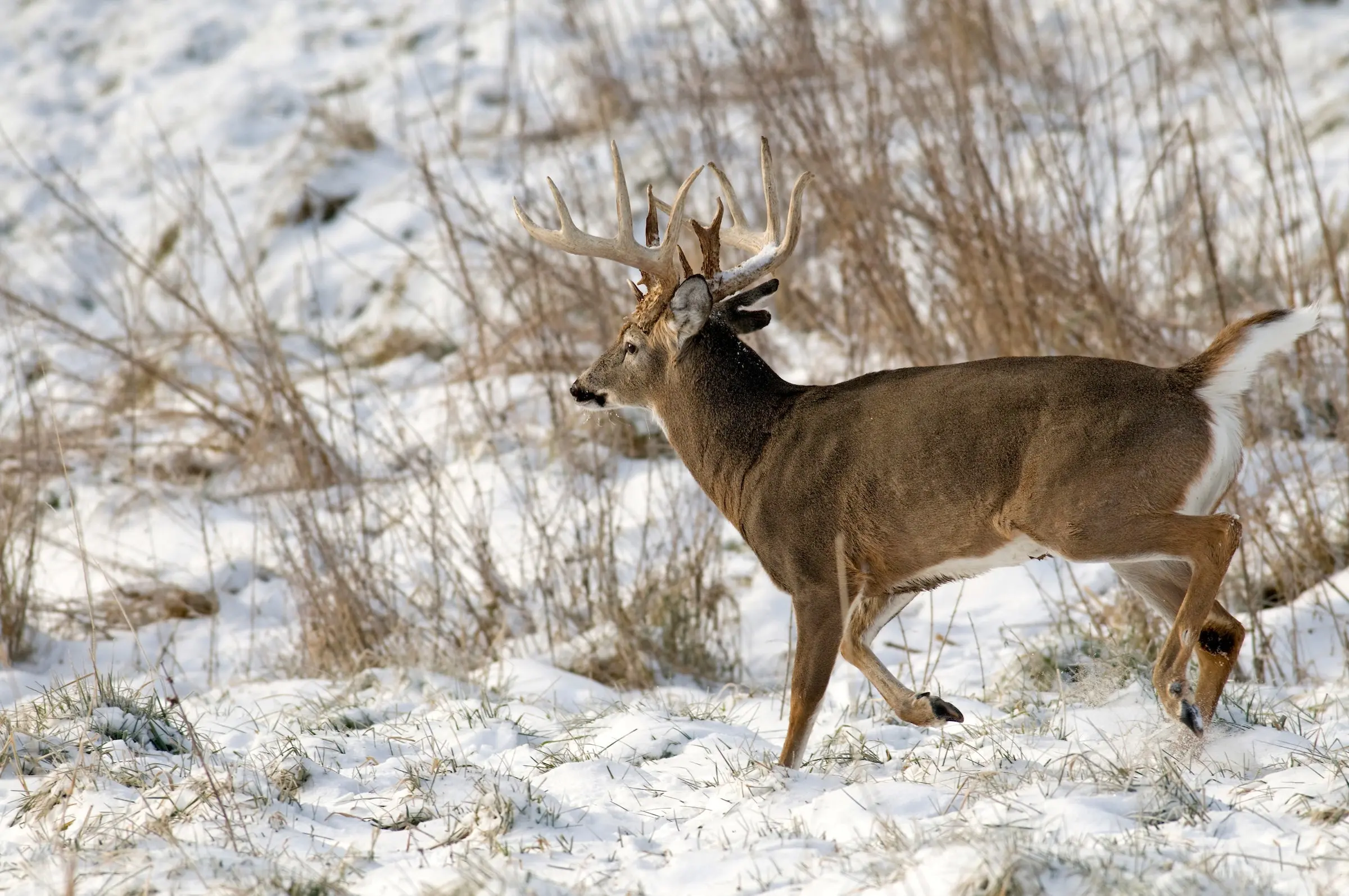
Late-season hunting is tough, but you’ll see lots of deer, including some of the biggest bucks. John Hafner Photography
As someone who typically hunts as many days as possible during my home state’s 100-day archery season—a generous framework that encompasses every phase of whitetail behavior from late summer to winter—it took me awhile to realize that December was my favorite 30-day period during that stretch. Some friends look at me like I’ve got two heads when I make such a confession. They point to those glory days of September, the excitement of the rut, or the contagious enthusiasm of the firearms seasons. But I stick to my guns and cling to the stark and frigid 12th month.
Why? There are several reasons. First, the hunting dynamic is a simple as it gets in December: Find the food and you’ll find deer. And not just deer, but likely some of the best bucks of the season, animals so intent on feeding that they’re unusually predictable. What’s more, there are almost zero other hunters out now, as most have either filled their freezers or simply given up on deer for the year, content to watch football or partake in holiday parties and look forward to the promises of next year.
Of course there’s no sugar-coating the difficulties of the hunt now. The best deer movement occurs when the temps make sane folk stick indoors; the snow and sleet comes sideways and the wind will chap your cheeks and crack your lips. And don’t forget the deer, animals who’ve been spooked, harassed, and shot at for over three months and are so wary they’ll flee from any hint of danger. Fooling a buck now practically proves your skill as a hunter. And because of those challenges, that late season buck, regardless of size, will be among your most cherished trophies ever.
3 X-Factors That Affect the Best Times to Hunt Deer
Times of day and phases of the season are the bedrock considerations when it comes to choosing the best times to hunt deer, but not the only. Just talk to any seasoned hunter, and he’ll gladly pontificate on his theories regarding weather, moon phase, barometric pressure, and more. So let’s look at these X-factors.
1. Weather
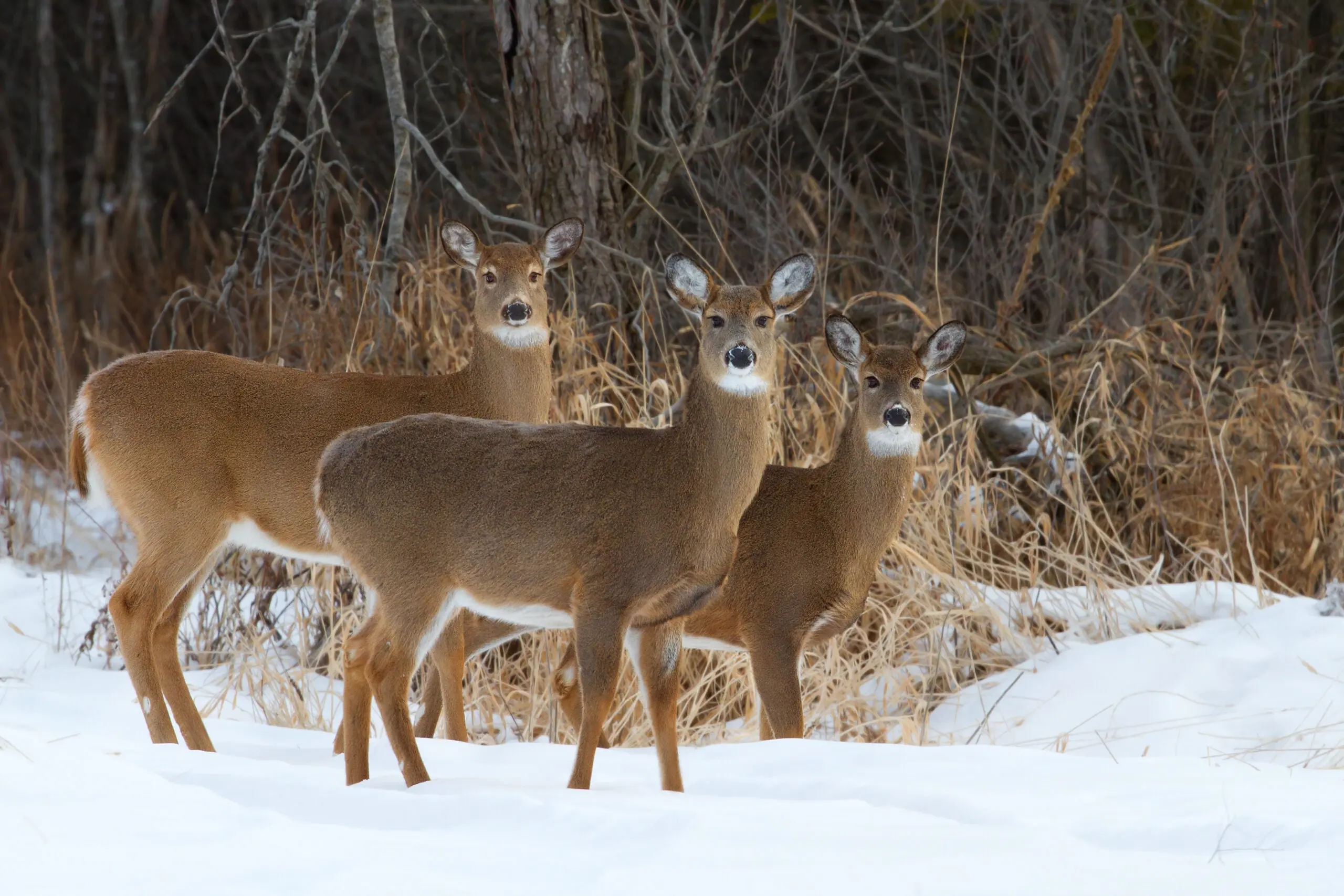
Any seasoned hunter will tell you that bitterly cold weather puts deer on their feet. Getty Images
While we give temperature and weather a fair amount of weight in the sections above, this is actually a point of debate lately. Telemetry studies suggest that factors like temperature, wind, precipitation, and barometric pressure don’t have much effect on when or how often whitetails move. In fact, a recent look at weather and deer movement on the [National Deer Association website](https://deerassociation.com/hunting-cold-fronts/Mississippi State Deer LabTemperature)
pooh-poohed the relationship between increased deer movement and cold temps. My friend and a respected writer, Lindsay Thomas, quotes at least two noted researchers who dismiss any link between the thermometer and whitetail activity, and their arguments are logical and backed by data.
But—and it is, as my kids like to say, a big “but”—that story focused largely on the rut, and, of course, nothing is going to stop whitetails from engaging in the annual breeding ritual that keeps the species alive. Outside of the rut, things get more interesting. I’ve hunted virtually every late-season archery or muzzleloader hunt in the upper Midwest for the last 35 years, and if a telemetry study could show no relation between daytime deer movement and weather, I’d be shocked. As countless late-season hunters will tell you: More deer are on their feet and moving earlier when it’s freeze-your-nose-hairs cold. Period. And I’ve found that whitetails seem totally tuned in to relative temps; if it’s been 35 degrees and suddenly drops to 20, deer feed with what seems like desperation. But if it’s been minus 10 and the temps soar to 20, deer get lazy again.
2. Barometer
I’ll admit that I don’t track barometric pressure religiously. But when I am paying attention, I do have to say deer (and other wildlife) seem to be more active on high pressure days and/or when the barometer is moving. This would tie into many hunter’s beliefs that approaching or departing weather fronts influence deer activity, and there are no shortage of guys, many of whom have killed more and bigger deer than I have, who swear by this relationship. I’d suggest that keeping a journal of conditions after each hunt will help you make an informed decision on this topic yourself.
3. The Moon
I would dearly love to never talk about the moon and deer movement for the rest of my life. The lunar influence on when, why, and how deer move has been debated for years, with a once-prominent whitetail writer even arguing that lunar cycles altered the timing of the rut, and in some years by several weeks. This theory was basically blown out of the proverbial water by data revealing that the annual fawn drop occurred within the same handful of days each and every year, regardless of whatever moon antics occurred during October and November.
Others take a more moderate approach, contending that moon phase and/or position might have an effect on when and how well deer move. Here again, telemetry data has shown no clear relationship. Still, and again, some pretty serious and successful hunters are convinced there’s an important link and, as long as they’re not trying to sell me something, I’m willing to listen. After all, my grandma was a grizzled RN who served in Chicago emergency rooms for 30 years; she was adamant that their busiest days (and craziest cases) all fell in and around full moons. I doubt there was a scientific study backing grandma’s claims (there may be now), but I believed her.
Conclusion: Any Time Can Be the Best Time to Hunt Deer
It’s always fun to sit at a keyboard and tell others when they should be out in the timber, catching up with a whitetail. And, after a whole lot of years in the deer woods (this is actually season No. 50 for me), I’ve obviously come up with some opinions, some of which are backed by science and many backed by fellow hunters.
But let’s be honest. The absolute best time to hunt deer is still any time you can go. I’ve had close encounters and punched tags on days or time periods when it made no logical sense (at least, none that I could find) for a nice buck or a healthy doe to be walking past my stand. But even more important than that, even on the days when I got absolutely and thoroughly skunked, I generally learned something about deer and always had a great time. You can certainly up your odds by following the advice above, but even if the rut is weeks away, the temp is soaring, and there’s zero reason to believe deer will be active, always go when you can. Whitetails don’t read scientific literature and certainly not advice from outdoor writers, and I guarantee you’ll enjoy the hunt, even if all you see is a beautiful sunset.
Frequently Asked Questions
What time do deer come out in the morning?
Deer are crepuscular, which means they are most active at dawn and dusk. So, by the time legal shooting light comes on any given morning, many deer are already on their feet and feeding or they have finished feeding for now and are heading back to security cover to bed down for the day. How long deer are active in the morning varies. Sometimes, they’ll stay active into midmorning or beyond; other times the action can slow to a halt after a flurry of first-light activity. You never know, which is a good reason to stay in your stand a little longer.
What time to deer come out in the afternoon?
In very cold weather or during the rut, you might see deer out and about one minute past noon. But as a rule, the closer you get to dusk, the more likely you are to see deer, especially mature bucks. That said, most afternoon deer hunters plan to be in their stand or blind a few hours before dusk, just in case deer come out a little early.
What are the best deer hunting days for 2023?
The truth is that nobody can tell you with any certainty which days a big buck is mostly likely to walk past your or anyone else’s stand. The best we can do it offer some general guidelines. If you follow the advice above, you’ll be upping your odds for sure. We can also offer our best, educated guesses, as we do every year in our annual Best Days of the Rut
. I can’t promise you you’ll tag a buck on any one of them, but I can tell you that we gave them a lot of thought and picked them for good reasons.
![Field & Stream [dev]](https://images.ctfassets.net/fbkgl98xrr9f/1GnddAVcyeew2hQvUmrFpw/e4ca91baa53a1ecd66f76b1ef472932b/mob-logo.svg)





